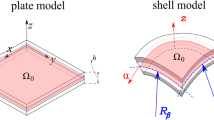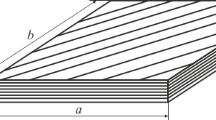Abstract
This paper presents an extension of the numerical reduction method, which has been proposed in Lejeunes et al. (Arch Appl Mech, 76:311–326, 2006), for modeling curved laminated structures of revolution such as for instance rubber bearings. This method based on high-order finite elements is developed in the context of nearly incompressible hyperelastic behavior. The displacement is approximated with a sum of independent functions, leading to a separation of variables. Therefore, a one-dimensional finite element can be formulated, which represents a 3-dimensional solid in a general loading case. Comparisons with classical finite element models are provided and show the reliability of this model reduction. An important decrease in the model size and a greatly reduced computing time, compared to standard models, is observed.
Similar content being viewed by others
References
Babuška I., Narasimhan R.: The babuška-brezzi condition and the patch test: an example. Comput. Methods Appl. Mech. Eng. 140, 183–199 (1997)
Babuška I., Ogden J.T.: Verification and validation in computational engineering and science: basic concepts. Comput. Methods Appl. Mech. Eng. 193, 4057–4066 (2004)
Boukamel, A.: Etude théorique et expérimentale d’un stratifié caoutchouc-acier en grandes déformations. Ph.D thesis, Université d’Aix-Marseille II (1988)
Chang C.H.: Modeling of laminated rubber bearings using an analytical stiffness matrix. Int. J. Solids Struct. 39, 6055–6078 (2002)
Cheung Y., Au F.: Isoparametric spline finite strip for degenerate shells. Thin-Walled Struct. 21, 65–92 (1995)
Cheung Y., Jiang C.: Finite layer method in analyses of piezoelectric composite laminates. Comput. Methods Appl. Mech. Eng. 191, 879–901 (2001)
Cheung Y., Kong J.: The application of a new finite strip to the free vibration of rectangular plates of varying complexity. J. Sound Vib. 181, 341–353 (1995)
Cheung Y.K.: Finite strip method in structural analysis. Pergamon Press, Oxford (1976)
Devries F.: Homogenization of elastomer matrix composites: method and validation. Compos. Part B Eng. 29, 753–762 (1998)
Dumontet, H.: Homogénéisation et effets de bords dans les matériaux composites. Thèse d’état, Université Pierre et Marie Curie Paris 6 (1990)
Foerch R., Besson J., Cailletaud G., Pivlin P.: Polymorphic constitutive equations in finite element codes. Comput. Methods Appl. Mech. Eng. 141, 355–372 (1996)
Fu, Y., Ogden, R. (eds.): Nonlinear Elasticity: Theory and Applications. Cambridge University Press, London Mathematical Society Lecture Note Series, 283 (2001)
Heisserer S.Y.Z., Hartmann U., Düster A.: On volumetric locking-free behavior of p-version finite elements under finite deformations. Commun. Numer. Methods Eng. 24, 1019–1032 (2008)
Holzapfel G.: Nonlinear Solid Mechanics. Wiley, London (2004)
Lejeunes, S.: Modeling of laminated rubber-like/metal structures with a numerical reduction method. Ph.D thesis, University of Aix-Marseille II, (2006): http://tel.archives-ouvertes.fr/tel-00090600/fr/
Lejeunes S., Boukamel A., Cochelin B.: Analysis of laminated rubber bearings with a numerical reduction model method. Arch. Appl. Mech. 76, 311–326 (2006)
Léné F., Rey C.: Some strategies to compute elastomeric lamified composite structures. Compos. Struct. 54, 231–241 (2001)
Marusak R., Becker E.: A finite element procedure for axisymmetric elastomeric solids under general loading. Int. J. Numer. Methods Eng. 36, 2031–2048 (1993)
Tsai H.C.: Compression stiffness of infinite-strip bearings of laminated elastic material interleaving with flexible reinforcements. Int. J. Solids Struct. 41, 6647–6660 (2004)
Zhong W., Cheung Y., Li Y.: The precise finite strip method. Comput. Struct. 69, 773–783 (1998)
Zienkiewicz, O., Taylor, R.: The Finite Element Method, vol. 2, 5th edn. Butterworth–Heinemann, Oxford (2000)
Author information
Authors and Affiliations
Corresponding author
Rights and permissions
About this article
Cite this article
Lejeunes, S., Boukamel, A. & Khedimi, F. A model reduction technique for laminated solids of revolution with a curved cross-section. Arch Appl Mech 80, 1085–1102 (2010). https://doi.org/10.1007/s00419-010-0427-6
Received:
Accepted:
Published:
Issue Date:
DOI: https://doi.org/10.1007/s00419-010-0427-6




